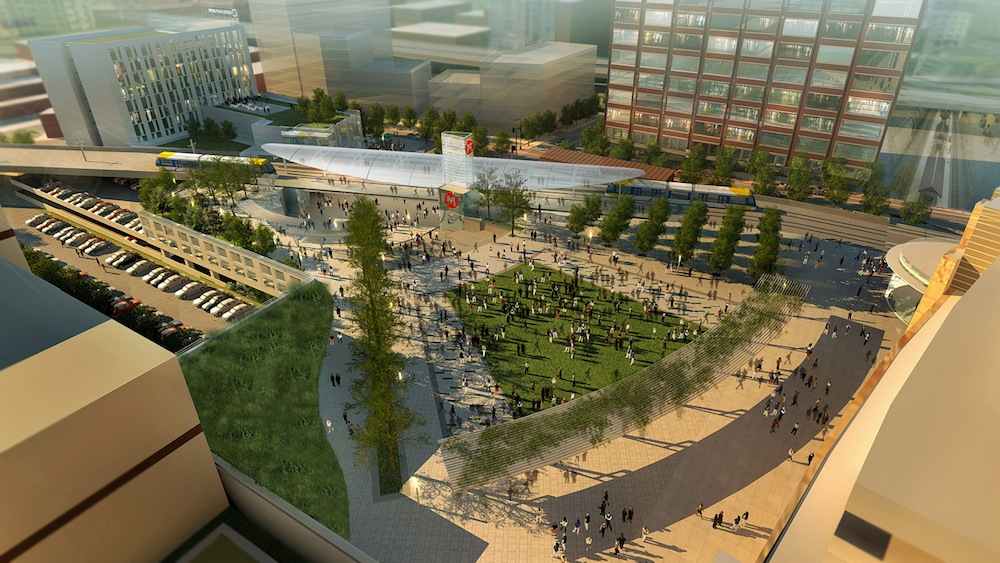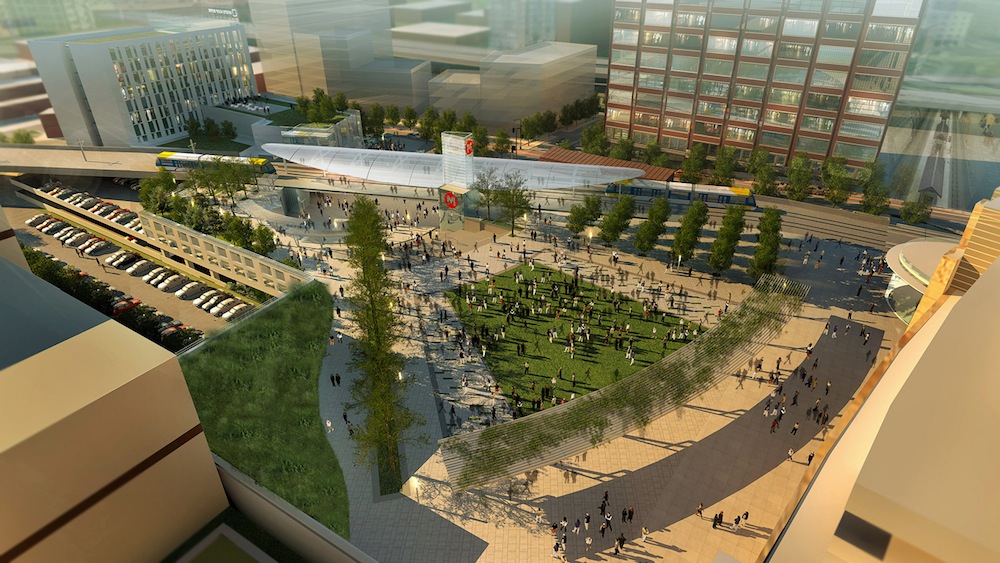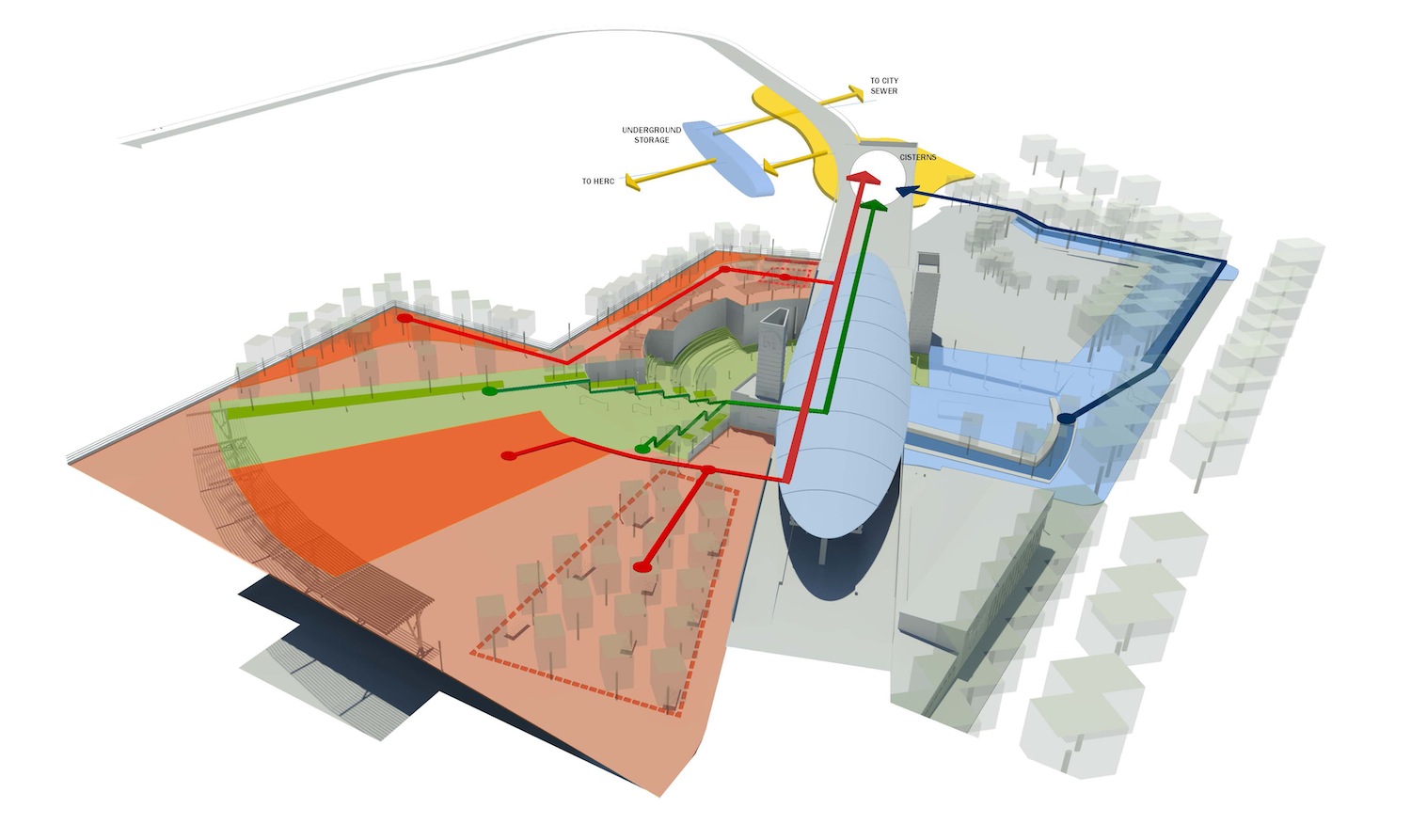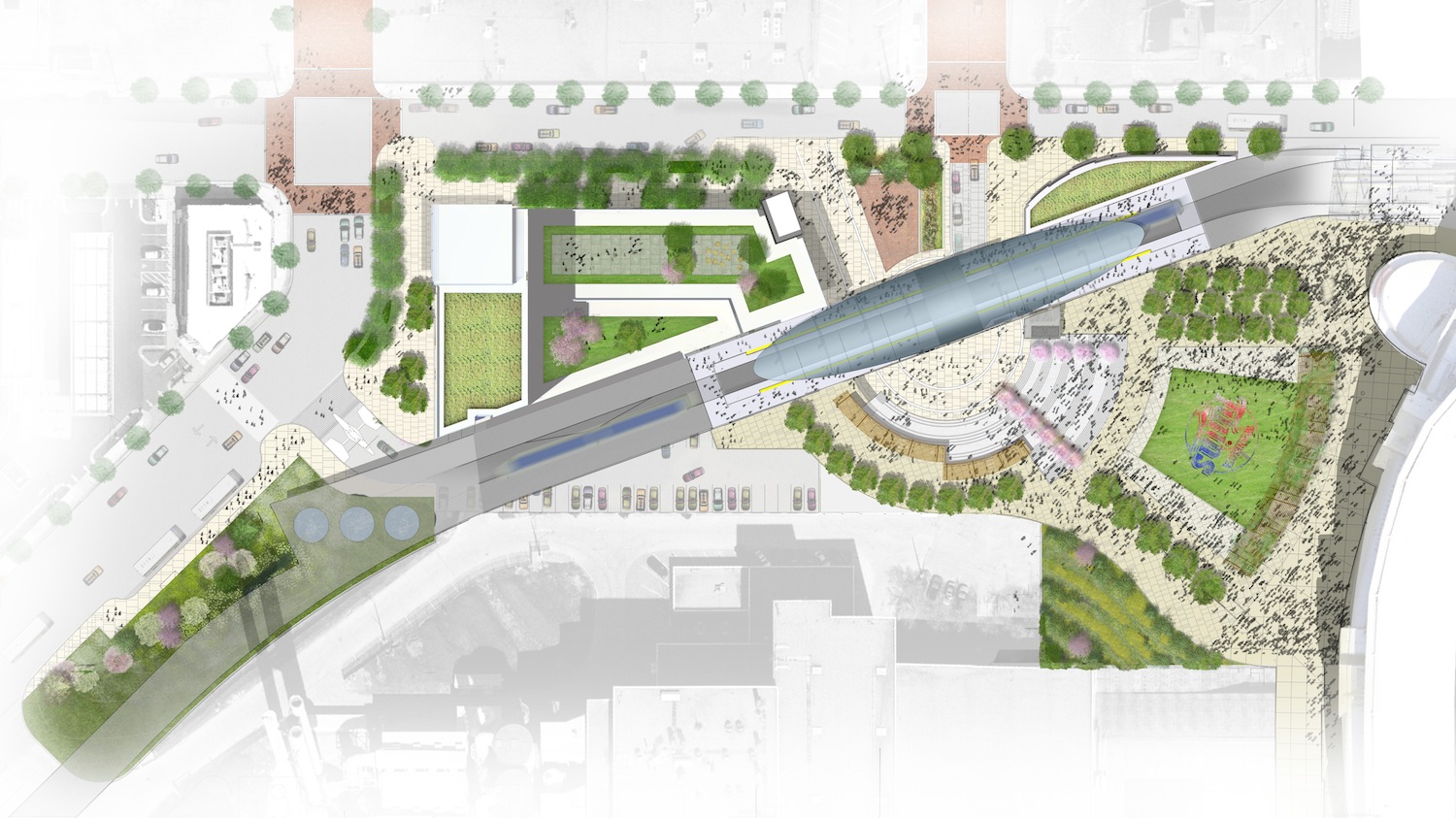Great cities are defined by great places. It is the avenues, squares, grand halls and, of course, the people who inhabit them that give a city its character. A unique blend of architecture, open space, transit, infrastructure, history, culture, and art, the Interchange represents an exciting vision of this character manifest in an urban environment. The goal for the Interchange is to create a place that is uniquely tailored to Minneapolis and its citizens—a place that is iconic, modern, and timeless. It will fulfill people’s aspirations for clean and efficient transportation while also serving as a proud calling card for those who call the city and metro area their home.
The Interchange will serve as the main transportation hub for the northern Minneapolis region. Situated a few blocks from the banks of the Mississippi River, the new station will connect approximately 500 arriving and departing trains daily, more than 1,900 daily bus routes, and hundreds of miles of bike and walking trails. This bold transit project is the result of a partnership between Hennepin County, the Hennepin County Regional Railroad Authority, and the Hennepin County Housing and Redevelopment Authority. It is funded by a mix of federal, state, and local sources, more than half of which comes from local government. During the construction phase, the Interchange will create more than 300 full-time local jobs. The design-build team is being led by EE&K a Perkins Eastman company and Knutson Construction.
Open Transit Design
History has taught us that the design visionaries behind the truly great transit destinations intended to create an infrastructure that functioned beyond as a transit hub. These projects used transit as a vehicle to design iconic spaces—the great hall, the retail passages, and the city sightlines that embody the culture of a city—while creating enormous real estate value. And this is what the City of Minneapolis and surrounding Hennepin County were trying to achieve with the Interchange. Designed by EE&K, a Perkins Eastman company, this nexus of transit and culture is based on a set of design principles called "Open Transit" that have been developed over the last 15 years.
Open Transit is a set of principles for modern station design that incorporate the surrounding spaces and additional modes of transportation to create an overall iconic place. If we are to make cities more sustainable we need to create transit places that will also sustain and enhance urban life and foster development. The Interchange exemplifies this concept in several ways: integration of all available transit modes, an orientation toward real estate development, architectural design that make places, and the integration of culture with transit design. The station will function as a backdrop to performance stage and appeal for non-transit users—people want to be there even if they aren’t using transit.
Making Development the Priority
The design of the Interchange is compact and connects seamlessly with the façade of Target Field, home to the Minnesota Twins baseball team. With such a modest footprint, the Interchange opens up the remainder of the site to maximize development opportunities. By leveraging the value of the 6th Avenue/5th Street intersection, this new development and subsequent ones within the site will help create a key link between the historic North Loop neighborhood and downtown Minneapolis. The Interchange will be a model for how transit design can stimulate economic development and foster environmental stewardship.
Transit centers designed according to the principles of Open Transit are development-oriented, meaning they catalyze investment in a region as much as they follow it. One of the current challenges of the site that the Interchange addresses is the massive influx of people to the area since the introduction of Target Field, which opened in 2010. And the opportunities it creates are even greater than the problems it solves. The team behind the Interchange explored at length how to integrate existing amenities into one new place that capitalized on a new transit line.
As a result, the hub will comprise the Cascade Amphitheater, a Great Lawn, and commuter-oriented retail. Each will provide the community with numerous programming possibilities that will serve the immediate and surrounding area year-round. The cascading staircase that can be used as an amphitheater, gathering space, and vertical transportation to the Great Lawn will draw people from all over for a relaxing picnic or a quiet respite from the bustle of city life.
The Interchange will create a new emblem of civic identity and community pride in its mix of uses by introducing the first of a new generation of facilities that truly integrate transit and culture. Like Grand Central in New York City, it will draw tourists, workers, shoppers and diners. As an oasis in a part of the city where large-scale freeway infrastructure collides with the historic grand warehouses of the North Loop neighborhood, it will fundamentally change Minneapolis and catalyze future development in the area.
Seamless Sustainability
The Interchange in Minneapolis pushes the lessons of Open Transit design even further with a holistic approach to the building as an environmentally responsible community member. It aims to help sustain Minneapolis's urban revival by incorporating features like rainwater collection for irrigation and building use, and a symbiotic use of water with recycling trash. The LEED-certified and Minnesota State-recognized B3 accredited development will use heat from the nearby Hennepin Energy Recovery Center (HERC) to heat sidewalks in the winter months. All concrete removed from the existing site will be re-incorporated back into the project, helping to curb costs related to trucking and the procurement of imported crushed rock. The new HERC administration building on the site is being designed with energy-efficient components, which will cut overall energy consumption by 30%.
Open Transit design represents the future of sustainable transit development in America’s vibrant urban centers, re-envisioning and refashioning the best of the past for the future. The Interchange in Minneapolis will be one of the most efficient demonstrations in the United States of how transportation can integrate with commerce and culture to create rich development opportunities.
Construction on the Interchange continues on schedule, and the project will open in April of 2014.
Related Stories
| Aug 11, 2010
Residence hall designed specifically for freshman
Hardin Construction Company's Austin, Texas, office is serving as GC for the $50 million freshman housing complex at the University of Houston. Designed by HADP Architecture, Austin, the seven-story, 300,000-sf facility will be located on the university's central campus and have 1,172 beds, residential advisor offices, a social lounge, a computer lab, multipurpose rooms, a fitness center, and a...
| Aug 11, 2010
News Briefs: GBCI begins testing for new LEED professional credentials... Architects rank durability over 'green' in product attributes... ABI falls slightly in April, but shows market improvement
News Briefs: GBCI begins testing for new LEED professional credentials... Architects rank durability over 'green' in product attributes... ABI falls slightly in April, but shows market improvement
| Aug 11, 2010
Luxury Hotel required faceted design
Goettsch Partners, Chicago, designed a new five-star, 214-room hotel for the King Abdullah Financial District (KAFD) in Riyadh, Saudi Arabia. The design-build project, with Saudi Oger Ltd. as contractor and Rayadah Investment Co. as developer, has a three-story podium supporting a 17-story glass tower with a nine-story opening that allows light to penetrate the mass of the building.
| Aug 11, 2010
Three Schools checking into L.A.'s Ambassador Hotel site
Pasadena-based Gonzalez Goodale Architects is designing three new schools for Los Angeles Unified School District's Central Wilshire District. The $400 million campus, located on the site of the former Ambassador Hotel, will house a K-5 elementary school, a middle school, a high school, a shared recreation facility (including soccer field, 25-meter swimming pool, two gymnasiums), and a new publ...
| Aug 11, 2010
New Jersey's high-tech landscaping facility
Designed to enhance the use of science and technology in Bergen County Special Services' landscaping programs, the new single-story facility at the technical school's Paramus campus will have 7,950 sf of classroom space, a 1,000-sf greenhouse (able to replicate different environments, such as rainforest, desert, forest, and tundra), and 5,000 sf of outside landscaping and gardening space.
| Aug 11, 2010
U.S. firm designing massive Taiwan project
MulvannyG2 Architecture is designing one of Taipei, Taiwan's largest urban redevelopment projects. The Bellevue, Wash., firm is working with developer The Global Team Group to create Aquapearl, a mixed-use complex that's part of the Taipei government's "Good Looking Taipei 2010" initiative to spur redevelopment of the city's Songjian District.
| Aug 11, 2010
Florida mixed-use complex includes retail, residential
The $325 million Atlantic Plaza II lifestyle center will be built on 8.5 acres in Delray Beach, Fla. Designed by Vander Ploeg & Associates, Boca Raton, the complex will include six buildings ranging from three to five stories and have 182,000 sf of restaurant and retail space. An additional 106,000 sf of Class A office space and a residential component including 197 apartments, townhouses, ...
| Aug 11, 2010
Restoration gives new life to New Formalism icon
The $30 million upgrade, restoration, and expansion of the Mark Taper Forum in Los Angeles was completed by the team of Rios Clementi Hale Studios (architect), Harley Ellis Devereaux (executive architect/MEP), KPFF (structural engineer), and Taisei Construction (GC). Work on the Welton Becket-designed 1967 complex included an overhaul of the auditorium, lighting, and acoustics.
















